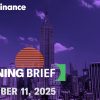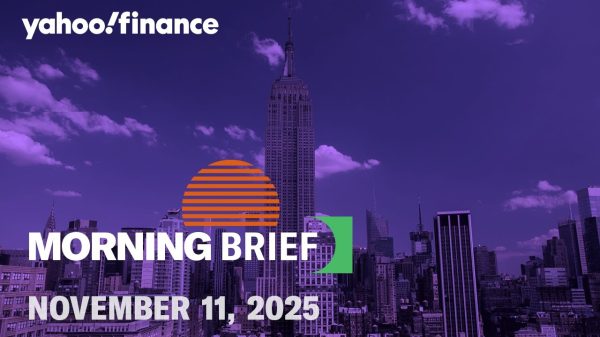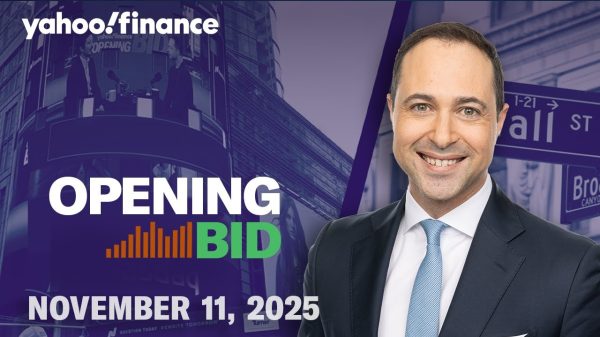Listen on the go – subscribe to Wall Street Breakfast on Apple Podcasts and Spotify
This is an abridged conversation from Seeking Alpha’s Investing Experts podcast recorded on July 17, 2023
- 0:35 – 25 basis point increase likely coming from Fed, already priced into the market
- 4:20 – Cooling inflation and how macro picture is affecting earnings
- 11:00 – Avoiding textbook recession; looking for troubling signs
- 18:20 – Favorite AI plays – the heavy lifters
- 21:40 – Financials earnings: as they go, the rest of the market usually follows.
Subscribe to The Financial Prophet
Transcript
Rena Sherbill: All right. Lay on us what you think about the Fed – what you think is going to be happening maybe near-term and post near-term?
Victor Dergunov: We know that it’s going to be at a 25 basis point increase next Wednesday. That’s about the probabilities of that are, like, 96% I’m looking now. That’s according to the Chicago Mercantile Exchange Group. So, there’s a very high probability that we’re going to see a 25% basis point increase. That’s already priced into the market in my view. That should not be a surprise to anyone. And another 25 basis point move. Here, it’s not really going to make a dramatic difference at all, I think.
So, what I’m looking for though is the statement, and I want us – we saw the inflation numbers come down. The CPI reading was actually very, very favorable, the last one. It was well below the estimate, and that should open up the door to a bit of an easier monetary stance from the Fed, I think, especially down the line.
They can probably hint to some kind of a stopping of the rate increase cycle, and perhaps we could start seeing the light at the end of the tunnel soon where the Fed is going to begin probably decreasing rates maybe early next year or maybe, I think, by mid next year. I’m pretty sure we’re going to see lower interest rates than now. And we can kind of confirm this probability by looking at the CME Group’s FedWatch Tool again, and we do see that we will probably see lower interest rates in – next year in 2024.
So, that’s positive for stocks, and that should be positive for risk assets in general. The big question is, will we see some kind of a more significant downturn in the market before the Fed kind of solidifies its position on an easier monetary stance? And I think we need to wait and see a little bit because we have seen a significant run up in stocks, but that doesn’t mean that we’re going to see a major sell-off.
We may just see another pullback in a little bit like we saw a nice little pullback recently of about 5% in the Nasdaq and that brought some high quality stocks down by 15%, 20%. So, we had some nice buying opportunities there. And that may be the theme from here if the Fed kind of levels out here. We may just see, like, a bit of a sideways to a slightly upward market in the next maybe several months, but we should see some buying opportunities arise in this time frame.
RS: How does this affect this thought process towards higher interest rates at some point in 2024 and a really bleak picture currently, and for the past period of time, let’s say at least 12 months, probably longer. Macro, speaking macro-wise, how are companies navigating this when it comes to earnings and forward guidance? And how are they projecting the future of their companies in terms of looking at the macro picture?
VD: So, I think it’s kind of company specific in many cases. But overall, we’ve seen the significant turn down. We’ve seen the earnings declines. We’ve seen the slowdown in ad spending and things of that nature. So, we’ve seen the big stock declines. So, I think a lot of the – much of the worst is probably behind us now, and companies, I think most companies recognize this.
And I also think that we need to look at the overall inflation image and most companies also obviously look at these factors as well, and inflation has been – has come down significantly.
So from about 9% to around 4% in the CPI over the last year. So, the Fed has done a fantastic job in moderating and inflation much better than I had anticipated. And I think they’ve done a fantastic job, and that’s primarily the reason why we didn’t see, I guess, more of a significant bear market.
The question is, will we have – will we continue to see the Fed doing a fantastic job? Will we see the soft landing? And can we avoid a significant slowdown? Because we know that we’ve been in a slowdown, it can continue. But the question at the end of the day remains how deep can it get, how deep can the slowdown get, how deep can the recession get.
So, that’s something that we don’t know 100%, exactly how deep it will get, but most signs, they point to that it’s not that bad. It’s getting better. It’s improving. Inflation is moderating, has moderated. We’ll continue to improve and should get to a level where the Fed can begin implementing a more accommodative monetary stance. And that would be even more beneficial for Corporate America.
And I think that most companies are considering this scenario, and they’re seriously considering this, and they are planning for the future on how to capitalize on future opportunities, where to invest capital, what to invest in, how to best optimize their AI platforms, and things of that nature, basically, because, again, America has the best and most innovative companies in the world. And they’re extremely efficient, just remarkable, amazing.
Just some of these earnings results that are coming in now from the big banks. And we had Pepsi (PEP) report and UnitedHealth (UNH) report, just last week. And they were just amazing results. And I think this is a prelude to a great, a much better-than-expected earnings season that we should have now. And I think that just goes to show how innovative and how efficient American companies can be at the end of the day. And that should really serve many companies well in the future.
RS: Do you feel that there’s talk of the inflation cooling for not stable reasons, let’s say, or not reasons that we can bank on and continue to rely on.
And to your point that a recession could still be lurking even though you don’t, it doesn’t sound like you foresee that as a strong possibility, the possibility remains. What are you looking at as signs that might happen in terms of the economy or from the Fed that you’re like, uh-oh, now I’m starting to get a little bit more nervous?
And in terms of your point about that it can be stock specific, or maybe even sector specific in terms of planning for these macro factors, how much of these strong earnings that are coming in are stock specific and how much are reflection of maybe the macro picture didn’t get as bad as we thought it was going to? It’s a lot.
VD: Okay. So, I’ll kind of start from what I can remember.
RS: Peel it back for us, Victor. Peel it back. I gave you a lot, I threw a lot at you.
VD: Yes. So, as far as the company earnings, yes, I think that there is quite a bit of relief in regards to the economic downturn not being as deep or as prolonged as many had forecasted or envisioned, so I think there’s relief on that front and we see that through the better-than-expected earnings.
And we see the rebound in earnings in many companies just some examples like NVIDIA (NVDA), they just – they gave the most amazing guidance I ever saw. It was like, instead of 7 billion, it was 11 billion for Q2 guidance, and that’s just remarkable.
And I’m using them as an example, but other companies also reported better-than-expected guidance, and that illustrates that really the downturn was not as significant as some had feared. So, that’s a good thing, and we should – we’d like to see a continuation of that trend and then improvement back to growth, of course.
Now, as far as the recession, I mean that’s a good question. And I’m always concerned about a possible slowdown and a more significant slowdown, but we have to put things in perspective in the regard that it’s a recession. It’s a very murky term, and now especially now that there’s so much, I guess, government involvement in the engineering of the numbers, the GDP numbers, that really, traditionally, I guess speaking, we would have already been in a recession, and we would have already, we’d be on the cusp probably of getting out of recession around now unless we were looking at a double dip scenario.
So, due to increased government spending incidentally or not, we did not – we, I guess, avoided a textbook recession, but in reality, we saw an earnings recession. So we basically already went through a recession or we are in a shallow session now, and that’s fine because it’s a normal economic process.
There’s no problem there. Just as long as we don’t have systemic damage or extreme panic, like, we saw in some instances, like, after the financial crisis or during end of 2008. So, we don’t have – we don’t seem to have any anything that signals clear and present danger as we saw back in those days. So, that’s a really good thing.
Now, as far as looking for troubling signs, the main thing here I believe is the labor market because that’s sometimes is like the last domino to fall. And if it falls hard, it could have a significant effect on consumer spending in the overall economy. So, that’s something that’s probably the most important indicator now, and it’s been coming in better-than-expected in recent months and that’s good.
But that’s the one that we need to watch for any significant changes because if we start seeing negative non-farm payrolls numbers, that’s going to be very negative for the stock market.
We want to avoid the labor market dipping into negative territory. That’s number one. And then, of course, inflation is very important. And when we see a very good trend in the right direction, and we want to continue seeing that. But we don’t want to see – we certainly don’t want to see anything resembling deflation because that would be extremely negative for risk assets.
So, we definitely want to avoid that. And preferably, we can get down close to the 2% range. And if we don’t get to the 2% range, that’s fine. We can – I believe the Fed will become accustomed to higher inflation maybe in the 3 – maybe around 3%, possibly a little bit higher, maybe 3.5%. And perhaps that could be considered a relatively normal rate of inflation in the future.
And this may be a conflicting – this may be, not a conflicting view, but possibly a contrarian view that some people may oppose, but I can say that the Fed and the government, they have different ways of measuring inflation, and there’s always room to maybe tweak the numbers a little bit. And it’s also possible that the economy could function relatively well at a slightly higher normal rate of inflation. It doesn’t have to be 2% in my view. I think that’s too much of an outdated approach.
I think that sticking to a 2% target rate at all times may not be the best policy. I think that it needs to be more of a floating rate. And in some instances, I think it’s fine to have a 3%, maybe even slightly higher inflation. And 2024 maybe, 2025 maybe, the years that the Fed may be changes their stance a little bit to possibly a bit of a floating rate or maybe something like that, that’s what I think.
RS: Talking about tech for a second, you mentioned NVIDIA’s outstanding guidance, and we’ve seen a lot of outstanding performance from NVIDIA and some other tech names. And there’s been some complaints to that regard in terms of the index construction in the markets. Do you have an opinion or thoughts about that?
VD: I could see how that could raise some controversy, and that’s actually the word that I was looking for, controversial view on inflation. Yes. I could see how that could raise some controversy, the huge weight of the mega cap names.
I think, like the eight biggest tech companies account for something like 40% of the Nasdaq 100 or close, 30% to 40% and probably about around 25% to 30% of the S&P 500, which is pretty massive. So, obviously the big moves in these mega cap tech names will influence the major averages significantly, but I can’t see that that I have a major problem.
I don’t have a major problem with that because tech is such an innovative and such a forward moving sector, and it’s in my view, it’s so much more important than many of the other segments. And technology, kind of, I don’t want to say that it rules the world, but it kind of enables all the other parts of the economy and sectors too to function properly. So, technology is certainly the most important segment by far. I don’t think it’s a big deal that the big technology companies account for the significant weight in the major indexes, I think that’s normal.
RS: And so, how are you thinking about the tech sector? How are you thinking about AI, and talk of hype and what companies are you, I guess, focused on? And what would you encourage investors to focus on and to be aware of in that sector?
VD: So, definitely, we’ve seen some hype in the AI segment. But I think we’re very early in the AI revolution. We’re maybe in the second inning or something. So we still have a long way to go, and it’s going to be a huge market, a massive market. And I think many of the high quality companies that are excelling in AI now and have the best AI programs, AI platforms, have the most AI potential, and should reap the benefits as we move on and many of these companies should do extremely well in the future.
And just several of my favorites that I have in my portfolio include Palantir (PLTR), Tesla (TSLA), (AMD), of course, Google (GOOG) and Amazon (AMZN) have some AI potential. Also, I don’t own it now, but I like the potential that Meta has, Facebook Meta (META). I think these companies are very well-positioned to capitalize in the future. Also, Baidu (BIDU), a Chinese company that I’m keen on has, also has a lot of AI potential.
And there are a lot of companies that have – that are promising AI programs, of course, like NVIDIA has an excellent future in AI, and it should – it could propel them to be even a lot more profitable in the future. So that’s what we’re looking at here.
Some of the companies that really do a lot of the heavy lifting, like NVIDIA and AMD, and other chip stocks that are – chip companies that are involved in AI, these are the ones that are going to be kind of putting in a lot of the leg work with their processors. So, these are the companies that should do really well in the future because AI, it looks extremely promising. Something that’s going to generate just billions and billions and then trillions of revenues and profits in the future.
RS: When news comes out like China putting restrictions on some of the chip companies, does that put you back at the drawing board in terms of working out guidance for the coming years? Or is that stuff that you figured in because as you said, it’s a burgeoning industry that we’re watching grow?
VD: It’s something that’s a little concerning. It’s something that we need to keep an eye on. It’s something that could impact future sales and growth and profitability. But on the other side of the equation, we also need to consider that there’s plenty of growth outside regardless of China. There’s plenty of growth. Another factor to consider is that any Chinese imposed sanctions could be transitory, temporary, short lived, whatever.
So, there’s no guarantee that they’re going to be long lasting. Another factor we need to consider is that China has its own companies that have significant AI potential and we can invest in those, like in Baidu, whether we do that in ADRs on the New York Stock Exchange or whether we do that or the Nasdaq or whether we do that by owning these stocks on the Hong Kong Stock Exchange, it doesn’t matter, but we can get exposure to the best in Japan as well.
And at the end of the day, it’s about having the best companies in your portfolio, their stock price is going to appreciate the most, and I don’t think it really matters that much if China imposes sanctions or not. It’s a transitory factor that it doesn’t really impact my investment strategy too much, but I do consider it.
RS: I’d like to wind down with financial stocks and how they’re looking out of earnings and what you’re seeing out of the financial sector.
VD: I like the financials here. Well, some financials here. I think that – I think, well, we’re seeing the numbers as they come in, and they’re significantly better-than-expected. If we look, for instance, if we look at who’s reported so far, JPMorgan’s (JPM) results were excellent. And, also, Citigroup (C) reported, and it was a better-than-expected quarter. And, also, I believe Wells Fargo (WFC) also reported, and they also beat on the top and bottom line.
So that’s great. And that’s basically what we’re looking for from other major financials. I mean, JPMorgan beat revenues by more than $2 billion. So, I mean, that’s, like, a 5% beat on revenues. That’s very impressive. That’s very impressive, and they beat by about $0.40 by about 10% on the EPS side, which is also phenomenal. And Wells Fargo had a beat on top – on both top and bottom line.
Citi beat on top and bottom lines, not by much, but it was still a beat. And I think we should probably see the trend of better-than-expected earnings continuing in financials and in other companies and most other companies as well because in my experience, if the financial earnings are good, then the rest of earnings season is also typically better-than-expected. As financials go, usually, the rest of the market follows.
So, we’re going to see what this earnings season has in store for us, but I think it should be better-than-expected, and I’m especially looking forward to the big tech names.
Editor’s Note: This article discusses one or more securities that do not trade on a major U.S. exchange. Please be aware of the risks associated with these stocks.
Read the full article here













